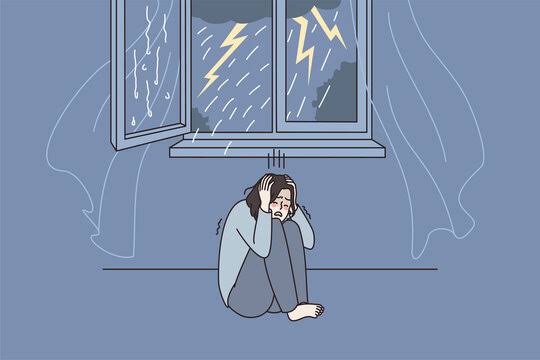Astraphobia, commonly known as the fear of thunder and lightning, is a prevalent anxiety disorder that can cause significant distress during storms. While thunderstorms are a natural occurrence, for those with astraphobia, the sound of thunder and sight of lightning can trigger intense fear and panic. Understanding the causes, symptoms, and treatment options for astraphobia is essential for individuals seeking relief and empowerment.
Understanding Astraphobia:
Astraphobia can develop due to various factors, including past traumatic experiences, learned behavior, or genetic predisposition. Negative encounters with severe storms, such as property damage or personal injury, can contribute to the development of astraphobia. Additionally, witnessing others’ fearful reactions to thunder and lightning, particularly during childhood, can influence the development of this phobia. Some individuals may also have a genetic predisposition to anxiety disorders, including astraphobia.
Symptoms and Impact:
Individuals with astraphobia may experience a range of physical and psychological symptoms during thunderstorms. Common symptoms include rapid heartbeat, sweating, trembling, shortness of breath, and avoidance behavior. The fear of thunder and lightning can significantly impact individuals’ lives, leading to avoidance of outdoor activities, difficulty sleeping during storms, and heightened anxiety levels during weather forecasts.
Treatment Options:
Fortunately, astraphobia is a treatable condition, and several therapeutic approaches can help individuals overcome their fear of thunder and lightning. Cognitive-behavioral therapy (CBT) is one of the most effective treatments for phobias, including astraphobia. Through CBT, individuals learn to identify and challenge irrational thoughts and beliefs about thunderstorms, gradually exposing themselves to controlled storm-related stimuli to desensitize fear responses.
Exposure therapy, a component of CBT, involves gradual and systematic exposure to thunderstorms in a safe and controlled environment, allowing individuals to confront their fears gradually. Virtual reality exposure therapy (VRET) is a promising alternative that uses immersive technology to simulate storm experiences, providing a realistic yet controlled environment for exposure.
Mindfulness techniques, relaxation exercises, and stress management strategies can complement therapeutic interventions, helping individuals cope with anxiety and reduce physiological arousal associated with astraphobia.
Empowerment and Recovery:
Overcoming astraphobia requires dedication, persistence, and a willingness to confront fears head-on. With the support of qualified mental health professionals and a personalized treatment plan, individuals can conquer their fear of thunder and lightning and regain control over their lives. By understanding the origins, symptoms, and treatment options for astraphobia, individuals can embark on a journey of empowerment and recovery, embracing storms with confidence and ease.
Source – Cleveland Clinic



